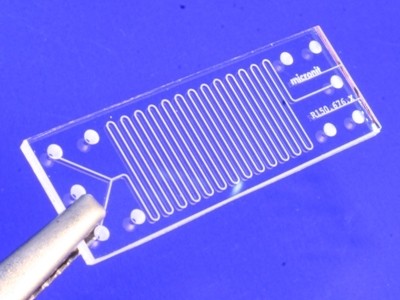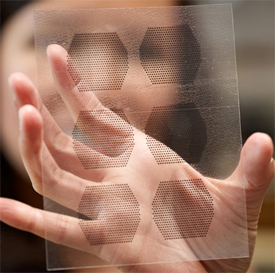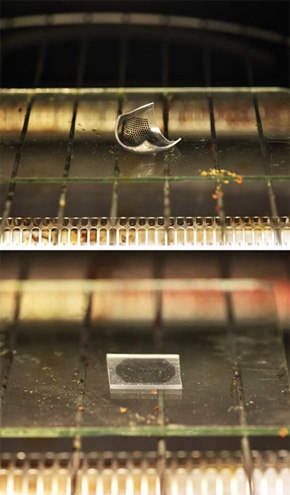The concept and potential of nanotechnology was first introduced by Nobel-Prize winning physicist, Richard Feynman, in his 1959 lecture, “Plenty of Room at the Bottom,” presented to the American Physical Society. With advancements in technology, Feynman’s theories are now being realized across a wide spectrum of industries.
Within biomedical engineering, bionanotechnology represents the application of nanotechnology to biology and biology to nanotechnology. As such, the terms bionanotechnology and nanobiotechnology are often used interchangeably. Bionanotechnology plays a critical role in both tissue engineering and drug delivery.
It’s All Relative
To get a sense of scale, consider that one nanometer is equal to:
- One billionth of a meter (that’s 0.000000001 m)
- 1/40,000 the width of a human hair
- About the width of six bonded carbon atoms
At this scale, the fundamental properties of common materials such as carbon and gold take on new potential.And this potential is being exploited in several areas of biomedical engineering.
Microtechnology
Microtechnology involves the miniaturization of mechanical processes and devices to accomplish tasks impossible to achieve at the macro level. Such tiny robots are being explored for their ability to deliver drugs, repair DNA, restore sight, and a myriad of other applications.
Sustained-Release Drug Delivery
At MIT’s Langer Lab, researchers are using nanotechnology to create sustained-release drug delivery methods. Expanding upon Robert Langer’s pioneering work in timed-release capsules, these researchers are working on polymer-based, biocompatible, degradable implants. Using microscopic, winding paths that slow the movement of drug molecules, such implants could deliver a drug for up to five years. Additional technologies could control the rate of drug delivery, either through external devices or through, say, a chip that could determine a patient’s blood glucose levels and adjust an insulin dose accordingly.
Targeted Drug Delivery
Not content to simply release a drug slowly over time, Langer and his researchers also want to make sure the drug reaches its target without creating unwanted side effects elsewhere in the body; particularly important with chemotherapy agents. So the drug molecules are first encased in the sustained-release capsules and then enveloped by polymers molded to fit their target cells.
The Langer Lab is also exploring how to use microbubbles to deliver highly targeted chemotherapy. Microbubbles are gas-filled bubbles between one micron (one micrometer or 1/1000 of a millimeter) and one millimeter in diameter. Someday, a chemotherapy agent could be encased in microbubbles and delivered systemically. Using therapeutic ultrasound, a technician could then burst only the microbubbles at the site of the tumor, remotely controlling delivery of the drug to precisely where it is needed.
Researchers are only just beginning to reach clinical testing, so it will be several years before these therapies are approved and available.
Microfluidics
Like carbon and other materials, fluids also behave differently at the micro level. The effects of momentum and viscosity, for example, influence how and whether fluids mix. Some of these small-scale behaviors can be exploited for both diagnostic and therapeutic benefit.
Much of the interest in microfluidics involves the analysis of small volumes of fluids that are manipulated through tiny fluid chambers to isolate specific cells or molecules. This so-called “lab on a chip” application allows for the development of inexpensive diagnostics by integrating the functions of one or more pieces of laboratory equipment on a chip. This is critically important in Third World countries, for example, to help enable healthcare workers to monitor the progression of AIDS.
 Lab on a chip. A glass microreactor made by Micronit Microfluidics.
Lab on a chip. A glass microreactor made by Micronit Microfluidics.
Lab-on-a-chip devices represent just one example of biological microelectromechanical systems, or Bio-MEMS, a type of microtechnology.
The Shrinky Dink Solution
When researcher Michelle Khine of the University of California, Irvine, found herself in a brand new lab as a founding professor at UC Merced, she did not have the specialized equipment needed to produce her microfluidic devices. So she wondered whether the Shrinky Dinks she played with as a child might work just as well.
Using some Shrinky Dink plastic sheets, a laser printer and a toaster oven, Shrink Nanotechnologies was born.
Recipe for Building Microfluidic Channels Using Shrinky Dinks
The Shrinky Dink approach allows researchers to design and fabricate working prototypes for their own microfluidic devices in just a few minutes.
What You’ll Need:
- Shrinky Dink sheets (available at craft stores)
- Computer
- Laser printer
- Toaster oven
- Metals (optional)
The process:
- Create a pattern on screen
- Print to a Shrinky Dink sheet
- Pop the sheet in the oven for 3-5 minutes
- The ink will uniformly pull together in the oven to create micro channels
Professor Khine’s story represents a great example of the translational research being done by biomedical engineers. The work of biomedical engineers in academia regularly finds its way to the market, either through large companies that fund and/or license the work or through companies developed by the researchers themselves.

